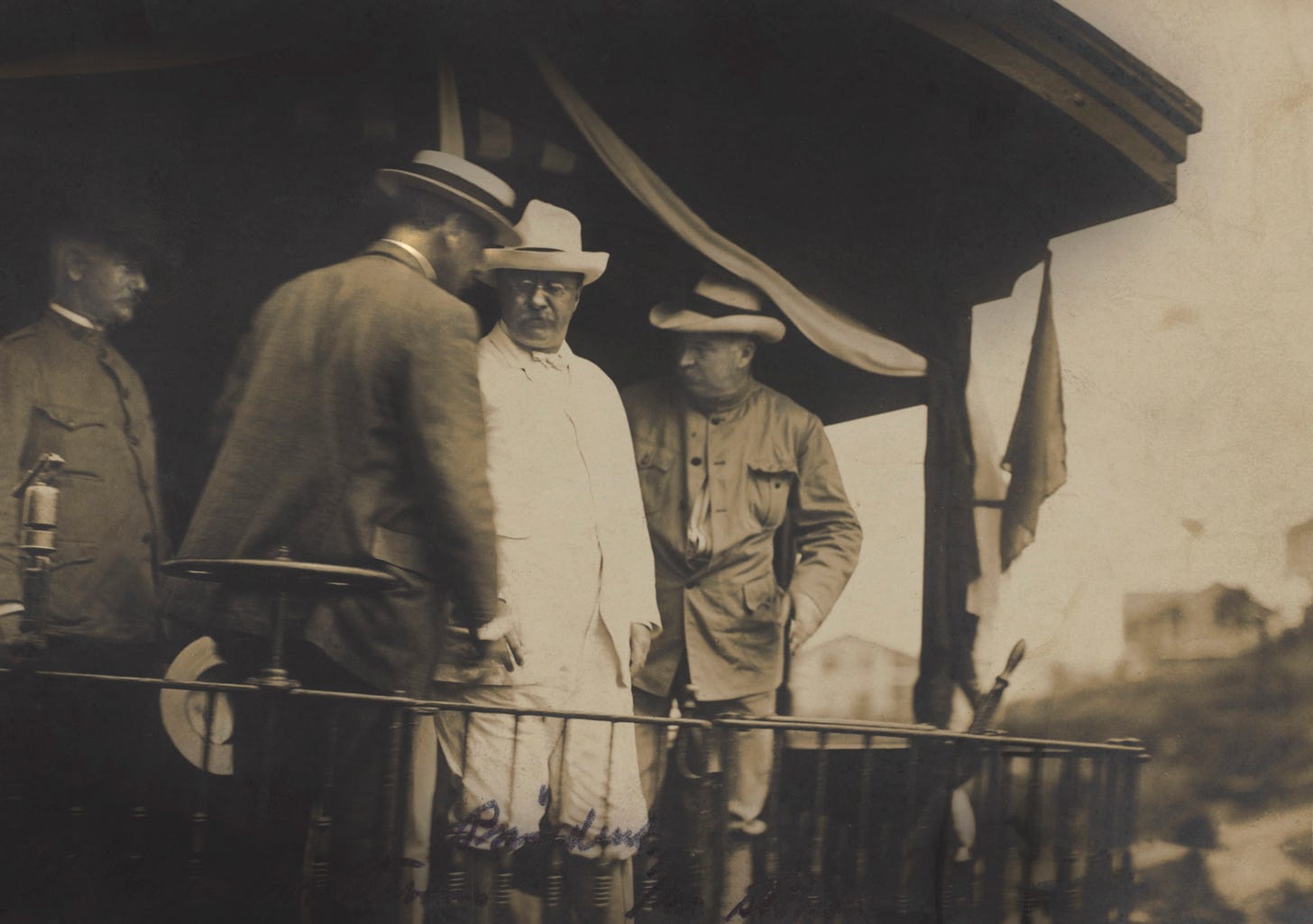
Biden’s Trip Abroad—and TR’s
What presidential trips tell us about America’s standing in the world.

President Joe Biden’s first international trip—a busy European visit that includes both international conferences and one-on-one meetings with world leaders—offers an occasion to look back at the first time a president made a foreign trip while in office, and to think more clearly about America’s changing role in the world. President Theodore Roosevelt’s tour of Panama and Puerto Rico 115 years ago marked the rise of the United States as a global empire, while Biden’s trip reveals a decline in American prestige and supremacy and the fragility of our alliances.
Biden’s trip includes the annual G7 conference, where the focus will be on the international COVID-19 vaccine campaign and climate change, as well as a NATO summit, where he will reassure America’s allies of our commitment to transatlantic security. Yesterday’s meeting in the United Kingdom with Prime Minister Boris Johnson was cordial, as will be Sunday’s meeting with Queen Elizabeth; meetings next week with Turkey’s President Recep Tayyip Erdoğan and Russia’s President Vladimir Putin could be more contentious.
Beyond the varied aims of each of these meetings, Biden’s overall trip serves three broad purposes. First, the president seeks to patch up the cracks that formed in our most important alliances over the last four years. President Donald Trump jilted longtime allies by withdrawing from critical international organizations and partnerships, like the World Health Organization and the Paris agreement on climate change, while cozying up to dictators around the globe. Biden can’t erase the harm Trump caused, but he can reassure our international partners that the United States is still a trusted ally.
Second, because much of the world increasingly views the United States as an undependable ally, its ability to influence policy and defend democracy is diminished. During four years of Trump leadership, the U.S. standing in the world plummeted. Biden’s trip aims to restore good will among democracies to fight encroachment by authoritarianism.
Finally, and relatedly, Biden will foster international cooperation on global issues like the pandemic and climate change. These issues require participation by the entire international community; they can’t be solved by an America First strategy. Yesterday, President Biden announced details of a plan to donate 500 million doses of the Pfizer vaccine to “92 low- and lower middle-income countries.” In addition to being good public health policy, this announcement is timed to help facilitate further partnerships at the upcoming summits.
In short, the entire trip reflects the Biden administration’s understanding of what has been called the “post-post-Cold War world” and America’s role in it: a superpower that can no longer take its global leadership for granted and that needs alliances and the good will of other nations to achieve its strategic imperatives.
The context of Teddy Roosevelt’s first foreign visit—the first such trip by a sitting president—presented a very different picture. The United States in 1906 was not yet a superpower, but it was on the rise. The burgeoning empire was eager to protect its interests through intimidation or conquest, if necessary. In December 1823, President James Monroe had promulgated the “Monroe Doctrine,” which declared that the Western Hemisphere was closed to further imperial expansion by European empires. In 1905, Roosevelt added a corollary, which announced that the United States intended to protect the status quo of independent nations in the Western Hemisphere from European interference.
Notably, the United States was exempt from the limitations in the Monroe Doctrine and the Roosevelt Corollary. A convenient exception, as Roosevelt had willingly used force just a few years prior to safeguard American access to its new canal project in Central America. In November 1903, he had sent American warships to Panama City to “encourage” Panamanian independence and the sale of the territory that the United States required for the Panama Canal. On November 9, 1906, TR visited the construction site to inspect the progress and encourage the laborers working on the site.

Headlines from the Los Angeles Herald dated November 9, 1906.
After his tour of Panama, Roosevelt traveled to Puerto Rico. Congress had passed the Foraker Act three years prior, which granted Puerto Rico “unorganized territory” status and gave Puerto Ricans limited constitutional protections. Roosevelt and his administration believed full statehood impossible because Puerto Ricans had to “first learn the lesson of self-control” before they could be trusted with self-government. Secretary of War Elihu Root justified this colonial paternalism: “They would inevitably fail without a course of tuition under a strong and guiding hand.” After returning from his visit, President Roosevelt delivered a speech to Congress reporting on his observations. He agreed with Root’s assessment: “It would have been a very serious mistake to have gone any faster than we have already gone in this direction [of self-government] . . . it would not be safe to make any change in the present system.”
When the Panama Canal was completed in 1914, it symbolized the technological prowess, emerging economic power, and imperial strength of the United States. Roosevelt’s trip eight years earlier had previewed this rise. He was able to create his desired outcomes—the Panama Canal and Puerto Rican dependency—through military force.
That sort of unilateral action is not feasible today. The world has changed enormously since TR’s day, and so has the position of the United States in it—first in a great crescendo of economic, military, and moral standing during and after the Second World War, and then amid the chaos, competition, and confusion that has followed the end of the Cold War. The United States remains very wealthy and militarily powerful, but the problems we now face—and those we expect to face in the years ahead—will require greater international cooperation, careful management of alliances, and the cultivation of good will. Biden’s trip is designed to make the most of this new world order.









